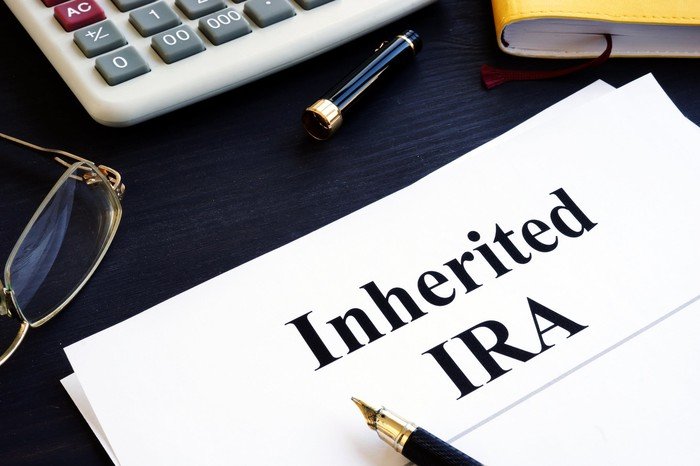If you've inherited an IRA, you are likely subject to required minimum distributions (RMDs), and you'll face steep penalties for getting these wrong. Read on for a breakdown of the RMD rules for inherited IRAs.

Inherited IRA RMD rules
Inherited IRA RMD rules
Like most things involving tax law, it's tough to dive into the details without clarifying a few definitions first. The table below explains some must-know terms about IRA RMDs for an account you've inherited.
| Term | What It Means |
|---|---|
| Eligible designated beneficiary | Eligible designated beneficiaries include the account owner's surviving spouse or minor child, a disabled or chronically ill individual, or any other person who's not more than 10 years younger than the original account owner. |
| Required beginning date (RBD) | The RBD is the date the original account owner would have had to start taking RMDs. The RBD is April 1 of the year after the beneficiary turns 73 (if the original account owner hadn't yet reached RMD age) or Dec. 31 of the year after the original owner's death (if the original owner had already reached RMD age). |
| Five-year rule | Under the five-year rule, the account must be depleted on Dec. 31 in the year containing the fifth anniversary of the account owner's death. |
| 10-year rule | Under the 10-year rule, the inherited account must be depleted on Dec. 31 in the year containing the 10th anniversary of the account owner's death. |
You'll see the relevance of these terms in the next table, which details the RMD rules for spouses, eligible designated beneficiaries, and non-eligible designated beneficiaries who have inherited a traditional IRA.
Surviving Spouses
Spouse may become account owner. Normal RMD rules apply based on spouse's age. Early withdrawals are subject to a 10% penalty. Or, spouse may take life expectancy payments based on his or her age. No 10% penalty applies at any time. If the account owner died on or after RMD age, RMDs must start the year following the account owner's death.
Otherwise, the spouse may be able to delay RMDs until the RBD.
Non-spousal Eligible Designated Beneficiaries
Beneficiary can take life expectancy payments starting the year after the account owner dies.
If the IRA owner died before 2020 and before RMD age, the beneficiary can withdraw all funds under the five-year rule. If the account owner died after 2019 and before RMD age, the beneficiary can withdraw all funds under the 10-year rule.
Non-eligible Designated Beneficiaries (Adult Children, Other Relatives, etc.)
If the IRA owner died before 2020, the beneficiary can withdraw all funds under the five-year rule. Alternatively, the beneficiary could take life expectancy payments starting the year after the account owner died. If the account owner died after 2019, the beneficiary must withdraw all funds under the 10-year rule if the original account owner died before their RBD. If the original account owner had already reached RMD age, their RBD is Dec. 31 of the year after the original owner's death.
Data source: IRS.
Calculating RMD life expectancy payments
Calculating RMD life expectancy payments
To calculate RMD life expectancy payments, you have to know about IRS life expectancy tables. The IRS uses three life expectancy tables for various RMD situations, but the one that applies to inherited IRAs is called Table I (Single Life Expectancy). You can find it in Appendix B of IRS Publication 590-B.
Use Table I to find the appropriate life expectancy factor for RMDs. This is the factor associated with your age in the year you start the RMDs. Divide that factor into the account balance as of the end of the prior year. The result is the amount you must withdraw from the account by the following April 1.
For example, suppose you're 45 years old, and you're calculating your first RMD on an IRA with a balance of $500,000. Your IRS life expectancy factor is 41, according to the IRS. So you'd divide $500,000 by 41 to get $12,195, which would be the amount of your first inherited IRA RMD.
In subsequent years, the calculation is the same, but the factor will change. If you are a surviving spouse, you'd continue using the life expectancy factor associated with your age. If you're a non-spouse beneficiary who's eligible for life expectancy payments, you'd reduce the life expectancy factor in each year by one.
Inherited Roth IRA rules
Inherited Roth IRA rules
The rules governing RMDs are simpler for inherited Roth IRAs, partly because Roths don't have RBDs. Most Roth IRA beneficiaries must take a lump sum distribution under the five-year rule or the 10-year rule, depending on when the account owner died.
Surviving spouses can take the lump sum option, but they also have two other choices. They can move the inherited Roth assets into their own name or take life expectancy payments based on their age.
Related retirement topics
Missed RMD
If you miss an RMD from an inherited IRA
The penalty for missing an RMD from your inherited IRA is 25% of the amount you should have withdrawn (previously 50% before the passage of the Secure Act 2.0). However, you may be able to have the fee reduced to 10% if you took quick action to correct the mistake.
You can request a waiver for the fine using IRS Form 5329, but you'll need a good reason for the oversight. An illness, death of a loved one, or a major household disruption caused by a move or natural disaster could be reasonable explanations.
There is one alternative if the RMD you missed was a life expectancy payment, but you are eligible for a lump sum distribution. You could change your distribution strategy and withdraw all funds under the five-year rule without penalty. That may not make sense financially, though, so check with a tax advisor first.
FAQs
Inherited IRA FAQs
What are the RMD rules for an inherited IRA?
Inherited IRAs rules vary based on the type of beneficiary. Most non-spouse beneficiaries must start RMDs by Dec. 31 of the year after the original account owner's death if the owner had already reached RMD age. However, if the original owner wasn't yet subject to RMDs, the beneficiary isn't subject to RMDs but must deplete the account within 10 years, depending on the account's terms. The rules are different, though, for spouses and eligible designated beneficiaries, or if the original account holder died prior to 2020.
Spouses have more flexibility. They can choose to treat the inherited IRA as their own or roll it over into their IRA. However, if the deceased spouse was required to take RMDs, they'll need to start RMDs by Dec. 31 of the year after their death.
Do inherited IRAs have to be distributed in 10 years?
Yes, if you inherited an IRA from someone who died after 2019 and you're not a spouse or an eligible designated beneficiary, you'll need to deplete the account within 10 years.
What happens when you inherit an IRA from a parent?
If you're not an eligible designated beneficiary, you'll need to either start RMDs by Dec. 31 the year after your parent's death (if they were already RMD age) or deplete the account within 10 years (if they weren't yet RMD age).








